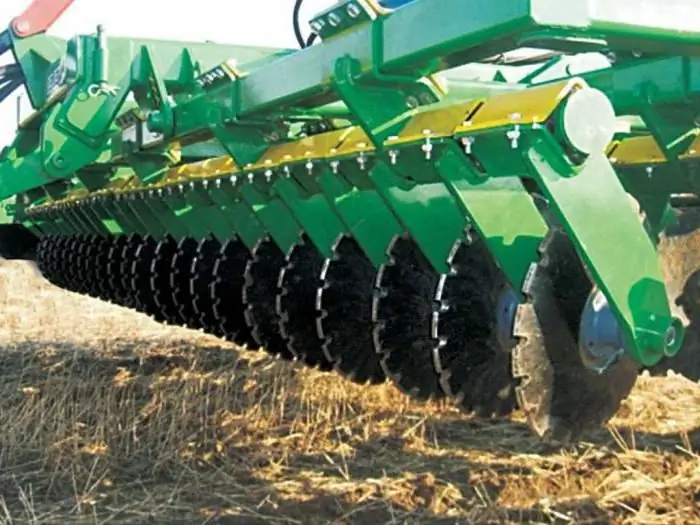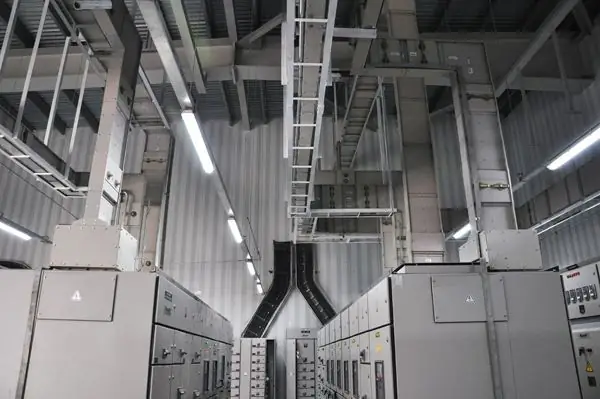2026 Author: Howard Calhoun | [email protected]. Last modified: 2025-01-24 13:10:47
In the process of harrowing the soil, loosening, mixing and leveling of its surface layer are carried out without reversing the layer. It is carried out with the help of agricultural machines - harrows. This is the short answer to the question "What is a harrow?".
Harrow technology
This process ensures the closure of moisture, to some extent contributes to the removal of weeds. Harrowing can be carried out before germination and after germination. As a rule, it is carried out perpendicular to the direction of crops or diagonally. It is carried out at a time when soil moisture is in the range of 50-70%, since neither dry nor waterlogged soil contributes to the correct deepening of the working bodies, which leads to poor-quality processing. Often combined with cultivation harrowing. And various harrows can be used: spring, disc, light, heavy, rotary, etc.

The speed of the tractor when performing this technique should be about 8 km/h, while harrowing winter crops in spring - 6 km/h.
Tooth harrows

What is a harrow? This is an agricultural tool designed to perform the harrowing process. Today, two types of harrows are produced: tooth and disc harrows.
Let's consider the first of them.
With the help of them, the soil can be cultivated up to 10 cm. Furrows when working with this type of harrow should be no more than 4 cm deep. Lumps should be destroyed up to a maximum of 5 cm.
Tooth harrows are divided into light (with a pressure on the working bodies of about 1 kg), medium (respectively 2 kg) and heavy (3 kg).
The heavy zigzag type harrow finds the greatest application. It is used to achieve harrowing targets for most crops.
The medium harrow is used on loose light soils. The depth of its processing is 5-6 cm.
Light harrows are used only for leveling the surface, lightly combing only emerging weeds and removing soil crust. The working depth of this harrow is up to 3 cm.
The working bodies of the harrow are represented by teeth, with the help of the front part of which the upper part of the soil is cut, and with the help of the side parts, the soil particles are moved apart, crushed, while clods are destroyed, and the soil elements are mixed.
Harrow frames can be rigid and articulated. The latter provide a better copy of the soil relief, resulting in a better uniformity of processing.
Teeth can be curved, straight and pawl. They are in the same rowdistance exceeding 15 cm, in order to avoid clogging with weeds and clods of earth.
One variation of this type of harrow is the mesh harrow, which is flexible and ensures uniform tillage even in uneven areas.
Tooth harrows are usually coupled with plows, cultivators, seeders, which, in turn, are aggregated with tractors.
The number in the title usually indicates the working width in meters.
Disk harrows
What is this type of harrow? As a rule, these harrows have wheels, except for those brands that are designed for processing thick turf.
The working bodies are discs that easily crush soil clods, loosen the soil and cut the turf. Each disc harrow is located at a certain angle in relation to the direction of movement, which is called the angle of attack.

Sod areas are treated with notched discs.
The frame with wheels is designed to control the depth of tillage. Compared to the teeth, the discs are less clogged with soil and weeds, they cut thin roots better and roll over thick ones. However, they cannot be used on rocky areas.
According to their purpose, they are classified into swamp, garden and field.
To work soddy soil, swampy soil, pastures and meadows, use a heavy disc harrow that can be adjusted to a depth of up to 20 cm.
Disks are mounted not one by one, but together, making batteries. The discs are separated from each other with a spacer spool. The square axles have bearings that ensure the rotation of the disk batteries, which are located on the frames in two rows, the front of which works in collapse, and the rear one in a stall.
Angles of attack are set depending on the hardness and moisture of the soil. Higher angles of attack are set on hard and dry soils (up to 21 degrees). A higher angle of attack ensures better immersion of the discs into the soil, and, consequently, better processing of it.
In addition to changing the angle of attack, the working depth is controlled by changing the pressure of the disc batteries on the soil by changing the mass of the ballast, as well as the compressive force of the spring mechanism.
Spring type device

Spring harrow is used for harrowing after harvest and crops. With its help, in addition, they perform the functions traditional for harrows: loosening and leveling the soil surface. In addition, this type of harrow is used for inter-row tillage, without damaging cultivated plants during this operation. It can also be used for embedding fertilizers, collecting hay and straw into windrows. This device is a kind of tooth harrow.
The working body of this harrow is a spring of a certain section. When loaded, it plays in different directions, so that at processing speeds in excess of 12 km / h, a more or less continuous overlap is provided.
Here, like a disc harrow, the angle of attack is adjusted.
BThe spring harrow "Agristar" has following sections, which provide uniform tillage independent of the terrain.
The depth is adjusted by changing the angle of attack, as well as changing the tension of the springs on each section.
Spring teeth can have different diameters, which allows these devices to be also divided into light, medium and heavy.
Some brands have the ability to mount an air seeder so it can be used to sow a variety of seeding crops.
Rotary device type

These devices are mostly called not just harrows, but hoe harrows. They are used mainly in areas of insufficient moisture, as well as in conditions when cultivated plants pass the phase of the possible use of tooth harrows.
The rotary harrow consists of pairs of discs, which are located on horizontal axes. The disc has wedge-shaped teeth with bevelled cuts. The working width of these types of harrows ranges from 1.1 to 18.3 m.
With the help of rotary harrows, you can close up fertilizers, crop residues. The processing depth can be up to 28 cm (for Polish models).
Trailed and mounted harrows
Harrows according to the method of aggregation are classified into trailed and mounted.

Trailed harrows have wheels that act as a support. This type is convenient for transportation.
Mounted harrows rely onworking bodies, they are usually small in size. During transportation, they are kept in the air due to the connection with the tractor.
Needle harrow
What is a needle harrow? This is a harrow used for anti-erosion treatment in combination with other agricultural machines instead of other types of harrows. Its passage ensures that up to 90% of the stubble is left, which prevents erosion. This type includes harrows BIG-3 and its modification BIG-3A.
One harrow has a working width of 3 m, aggregated with tractors MTZ, YuMZ. Three harrows are coupled with T-150 tractors, five with heavy K-700 tractors.
May, in addition to the traditional functions for harrows, destroy the ice crust on winter crops.
The device BIG-3 includes 4 sections in 2 rows, there are wheels. Like a disc harrow, the angle of attack is adjustable.
Working bodies are discs with 12 needles. The first row consists of 8 discs arranged in 2 batteries. The back row includes 9 discs. The angle of attack is 8-16 degrees.
Needle discs can be mounted in an active or passive state. With an active installation, the disks enter the soil layer with a bulge upwards, they exit downwards, with a passive one, vice versa. These methods affect the clogging of the harrow. Behind harrows there are gratings for cleaning discs. With passive installation, these gratings are less clogged.
Harrows can be used to create a wide-cutting unit, for which they are connected by restrictive chains in order to cultivate the soil without flaws.
Assembling the harrow yourself

For summer residents it is quite problematic to buy a tractor and a harrow for it. Some of them have walk-behind tractors, to which you can assemble a harrow with your own hands.
To do this, we take a metal pipe, weld the same strips, attach the teeth with bolts. At the end of the drawbar we place a metal finger to connect the harrow to the walk-behind tractor. It is also necessary to provide a stand for adjusting the height of the harrow, designed for uniform penetration of the working bodies. It is provided with an adjusting screw.
In closing
Thus, to the question "What is a harrow?" it can be answered that this is an agricultural tool used in agriculture to close moisture, comb out weeds and fight soil crust. Depending on the type of soil, its granulometric composition, and the amount of moisture in the region, various types of harrows are used.
Recommended:
Disk harrow mounted, sectional and trailed. Disc harrow: overview, characteristics, types and reviews

Pre-sowing tillage is unimaginable without a disc harrow - an agricultural tool that can simultaneously perform several operations: leveling the soil cover, loosening the surface, which prevents drying, destruction of the crust and destruction of weeds
Viewing well: description, device, types and features

There are many elements in the sewerage system that are designed to ensure the smooth operation of the network. The inspection well acts as one of the main structures, with the help of which specialists check the performance and clean the sewer
Main busbar: description, types and device, application

Power supply wiring in manufacturing plants and construction sites needs additional protection. Conventional insulation does not always cope with these tasks, so special circuits are used that also perform the functions of distribution and optimized connection. A typical version of such wiring is a trunk bus duct containing one or more power lines
Ejector - what is it? Description, device, types and features

Many people who have summer cottages could face such a problem as lack of water supply. In such cases, wells are usually dug, but it also happens that the water is too deep underground. In such cases, the ejector for the pump helps out perfectly
Corn seeder: device, types, features and reviews

Corn seeders are widely used in the fields of agricultural firms. The technique of this variety may differ in design, sowing method, type of dispensers, etc. Such seeders are supplied to the market by both foreign and domestic manufacturers

